"Sometimes you can say more by being quiet" says designer of UK's Milan Expo pavilion
Milan Expo 2015: to mark the opening of the British pavilion for the Milan Expo, Dezeen interviewed sculptor Wolfgang Buttress about trying to create a "quiet" structure in the middle of one of the world's biggest displays of "bombastic" temporary architecture (+ slideshow).
The €1.3 billion (£958 million) Milan Expo site opened to the public on Monday, but the beehive-inspired British pavilion designed by Buttress with engineer Tristan Simmonds was one of the first structures on the site to complete.
Called The Hive, Buttress' design is themed around the lifecycle of a bee and the contribution of bees to the planet's health. Its centrepiece is a cube with a honeycomb structure made from 169,300 aluminium and steel pieces. A globe-shaped hollow in the middle includes a glass platform so visitors can walk inside.
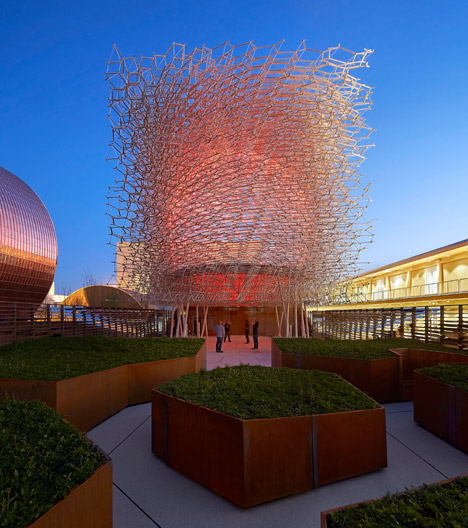
"In a way I wanted it to be the antithesis of the typical pavilion," Buttress told Dezeen at a preview of the pavilion last month. "A lot of them are big boxy sheds with some interesting cladding on them. Some are more successful than others."
"I'm not an architect, I'm an artist, so I was more interested in the experience and in how you could convey an idea and a feeling through an experience rather than an object or a building," he added. "I wanted to make something that is credible for what it is, a temporary structure, rather than do something bombastic. It would be easy to build a shed and say this is impressive. But I think sometimes you can say more by being quiet."
Lighting effects and music that plays around the pavilion both respond to the activity of bees in a hive in Nottingham, England, where an in-depth study of bee behaviour is helping tackle a sharp decline in populations of the insect worldwide.
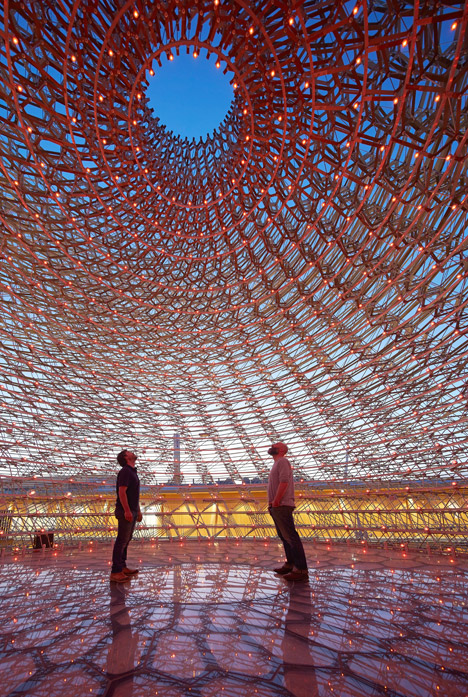
Unlike many of the structures on the Expo site, which will largely be demolished after the six-month exhibition concludes in October, The Hive is designed to be dismantled and rebuilt on another site in the UK.
"Here [in Milan], there is no context. You have to create your own little world," said Buttress. "At one point the Hungarian pavilion next to us was a really elegant timber wall with a cornfield next to it, which would have been lovely and quite harmonious. But you can't choose your neighbours."
"I think a lot of the pavilions have had technical problems," he added. "One of the reasons for working with Stage One, who built this for me, was that we could build everything in parts over in York and then transport it over here, so we were in complete control."
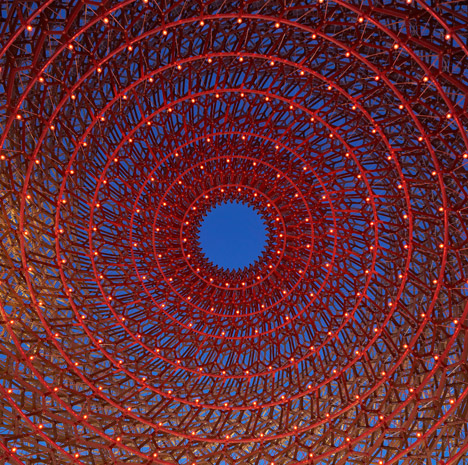
Nottingham-based Buttress took commentators by surprise when he won the job of designing the pavilion in May last year, beating a shortlist that included designers Barber & Osgerby and Paul Cocksedge, and architects Amanda Levete, Asif Khan and Allford Hall Monaghan Morris.
"One of the architects who works in my studio said 'are we going to apply for the Expo competition?' And my first reaction was no," said Buttress. "I thought every architect and his dog would be up for it and I'm an artist, not an architect."
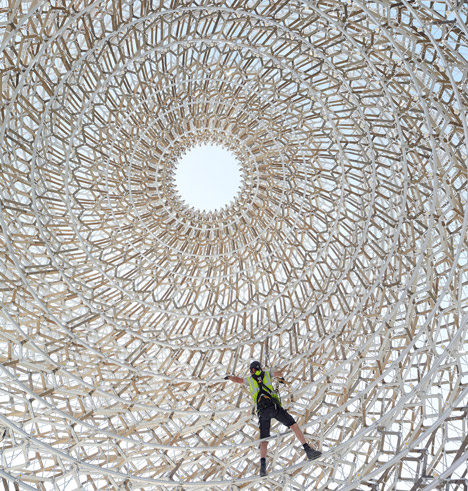
"I had this idea of taking a section of the UK countryside and transplanting it over to Milan," he explained. "Sometimes you're a slave to the idea and it's 'oh shit, now I've got it I've got to see it through'."
The competition attracted a range of big names partly thanks to the success of the UK's Shanghai Expo pavilion from 2010 – the Seed Cathedral by designer Thomas Heatherwick, which showcased 60,000 different seeds embedded into the ends of fibre-optic rods, creating a bristling structure that catapulted its designer to star status. Heatherwick is now working with Bjarke Ingels on the new Google headquarters in California.

Unlike Heatherwick, Buttress intends to keep his roster of clients limited and remain focused on art, rather than buildings.
"Thomas' career has just skyrocketed. He does buildings, design, furniture – everything. I suppose that's the big difference, I'm an artist as opposed to a designer," said Buttress. "For me it's also about being in control. Having too many things might feel like watering it down."
Photography is courtesy of UK Trade & Investment.
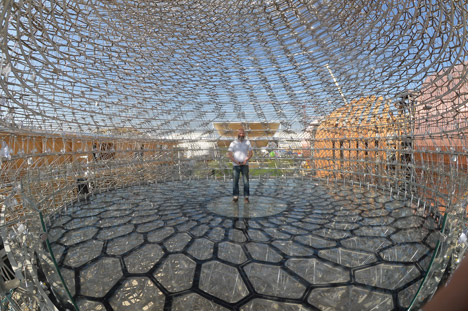
Read the edited transcript from our interview with Wolfgang Buttress:
Anna Winston: Can you introduce yourself, and explain how an artist ended up taking on such a structurally ambitious project?
Wolfgang Buttress: My name's Wolfgang Buttress and I'm an artist from Nottingham, UK. I'm a sculptor primarily. When I first left my degree I set up a studio in Nottingham. For three years I was the artist in residence at the local engineering college for two days a week. That was kind of like a playground in a way, so that's where I learned how to weld, how to make things, how to put things together.
As the years have gone on the projects have become larger and more ambitious. You surrounded yourself with a team that are like-minded. So there are some great fabricators and engineers that I work with. Tristan Simmonds for example.
Everything starts with a dream, with a sketch. And then it's a case of batting it forward, making little models, and then, for example with this sculpture here, I was trying to reduce the mass of it as much as possible. In a way I wanted it to be the antithesis of the typical pavilion. A lot of them are big boxy sheds with some interesting cladding on them. Some are more successful than others.
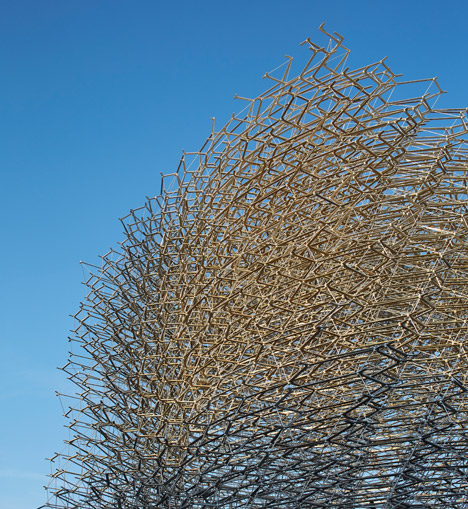
I'm not an architect, I'm an artist, so I was more interested in the experience and in how you could convey an idea and a feeling through an experience rather than an object or a building. I wasn't particularly interested in creating a sculpture in a landscape or a sculpture attached to a building – I wanted to synthesise them so it would be more like a collaboration, a harmonious synthesis between art, and architecture and science. For me, that's been really exciting.
On each of the projects you learn so much. I've learnt so much about the honeybee and how important it is. So this was a great opportunity to express that. The honeybee is almost like a sentinel for the health of the planet.
Anna Winston: Why did you decide to get involved with the project?
Wolfgang Buttress: It was an open competition. One of the architects who works in my studio said 'are we going to apply for the Expo competition?' And my first reaction was no. I thought every architect and his dog would be up for it and I'm an artist, not an architect.
Then I was talking to my wife, and she said: 'Well if you were going to do it, what would you do?' So I had this idea of taking a section of the UK countryside and transplanting it over to Milan.
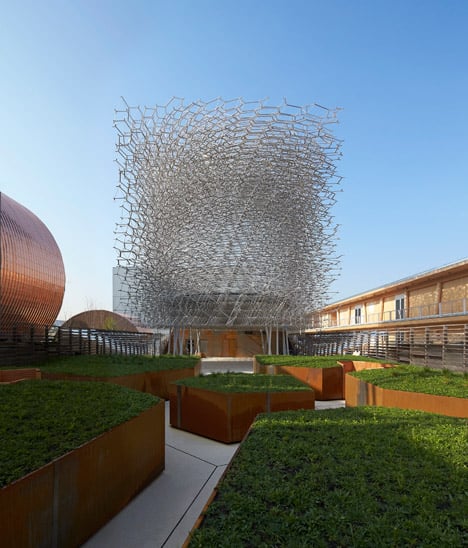
The theme of this year's Expo is Feeding the Planet, which is fantastic, it's really laudable. But how do you square that with building these nearly 150 pavilions all spending 10-20-30 million plus, which is a lot of money. There is an inherent contradiction and irony in that. So my thought was that if I was going to do something it needed to be quiet, it needed to be as sustainable as possible so that the sculpture itself could have a second life. And I was really keen to use landscape as the heart of it, so that the landscape becomes part of the work. It's a habitat for the bees, not just a backdrop.
Sometimes you're a slave to the idea and it's 'oh shit, now I've got it I've got to see it through.' I was up against some really talented people. I was kind of the outsider, so I didn't consciously look at the others. We though, well if we win it's great and if we don't at least you've given it your best shot. When we got the phonecall it was fantastic but there was also a sense of oh my goodness, now we've got to do it.
Anna Winston: It looks very different from everything else on the rest of the site.
Wolfgang Buttress: I think a lot of the pavilions have had technical problems. One of the reasons for working with Stage One, who built this for me, was that we could build everything in parts over in York and then transport it over here, so we were in complete control of everything. I wanted to make something that is credible for what it is, a temporary structure, rather than do something bombastic. It would be easy to build a shed and say this is impressive. But I think sometimes you can say more by being quiet, and whisper to people, and talk on a level rather than bragging and shouting. Hopefully that's what this pavilion will do.

Anna Winston: Does it look the same in the Expo context as you hoped it would look?
Wolfgang Buttress: That was one of the big challenges, because usually all of my work deals quite specifically with context. Here, there is no context. You have to create your own little world. That was why for me it was so important to bring the landscape and the art and the architecture together – that's the only thing you're in control of, creating this world, this piece of theatre.
At one point the Hungarian pavilion next to us was a really elegant timber wall with a cornfield next to it, which would have been lovely and quite harmonious. But you can't choose your neighbours. All you can do is what you're in control of.
The nice thing about this is that it will have a second life back in the UK. We're in a few conversations with people about this at the moment, so this time next year it will sprout up somewhere in the UK.
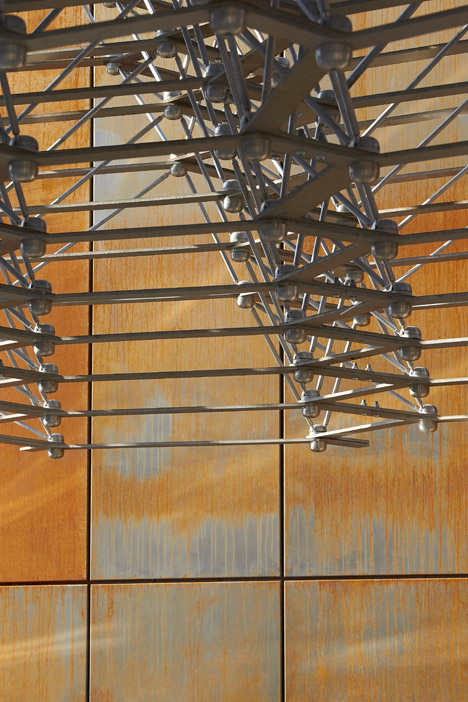
Anna Winston: The Shanghai pavilion had a pretty huge impact on Thomas Heatherwick's career. What do you hope happens next for you?
Wolfgang Buttress: My studio is eight to 10 people and I'm keen on keeping things not too massive. I like being hands on, I like being part of the process and working with the fabricators.
Thomas' career has just skyrocketed. He does buildings, design, furniture – everything. I suppose that's the big difference, I'm an artist as opposed to a designer. For me it's also about being in control. Having too many things might feel like watering it down. There's only so many projects I can work on – you're only awake for so many hours in the day, and you want to make the most of them and do great things.
Hopefully this will give me the opportunity to choose what those projects are going to be and choose them wisely, rather than take loads on. At the moment I'm turning a lot of work down, which is a nice position to be in.
I've already had an interesting conversation with Kengo Kuma. The potential to work with some of the great architects would be really amazing.
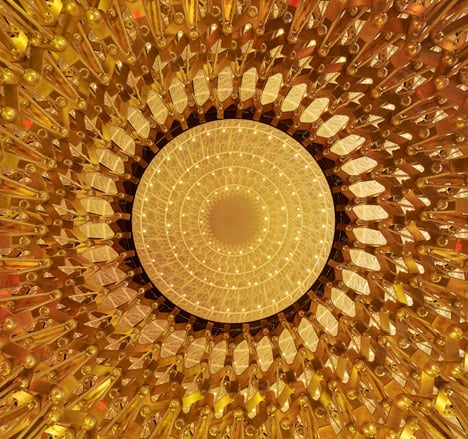
Anna Winston: Is there anything that you would have done differently on this project in retrospect?
Wolfgang Buttress: It's very similar to my original idea, the original plan, so at the moment I'm just looking at the minutiae, the small little snagging details. What's really exciting at the moment is working on the lighting and the sound, working with musicians like Spirtitualised and the violinist from Sigur Rós. There's all these people working on the soundtrack, which changes according to the bees. We're still in this space, in this dream. There's all these little things to discover and get excited about. I'm so in the middle of it it's very difficult to know what I would change. When the music comes in, and the meadow starts flowering, that's going to really make it sing.